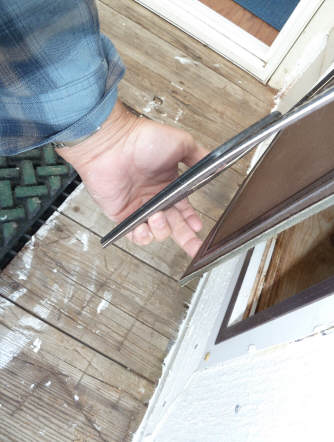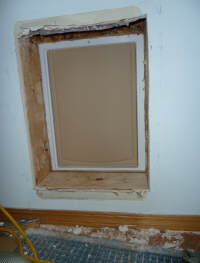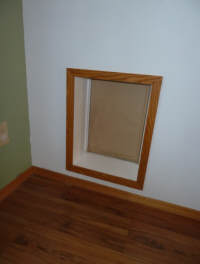
Search
The Renewable Energy site for Do-It-Yourselfers
Low Infiltration
Pet Door
| We had a blower door test recently, and one of the big air
infiltration leaks in the house was our pet door. This was a bit
disappointing as we had paid extra for a double flap model that was
supposed to provide good sealing. Even without the blower door to
point out how much the pet door leaked, is was pretty apparent if you
just took a good look at it. There were gaps that were clearly not
sealing anymore (if they ever did). A further indication was that
when the wind would blow, the flaps on the pet door would open
and close with quite a bit of noise -- to the point where we would have
to get up and install the shutter on the door to get some sleep.

The new, infiltration resistant dog door.
While looking for a solution to the leaky dog door, I ran across an
account on a new home blog about someone who had found and tried a pet door that was
supposed to seal very well. After investigating
a bit, we decided to give it at try. |
|
The door is the Freedom Pet Pass, and
is available at
www.EnergyEfficientDogDoors.com
The website has some interesting
videos and a bit of test data to backup their claims of good sealing and low
infiltration.
| |
Update: November 2014
1. We have been using the pet door since 2010, and it is still working fine and appears to be sealing as well as ever.
2. Donal Love from Freedom Pet Pass has sent in some links to testing on the insulating value of the pet door and on infiltration through the pet door that they had done for them by an independent testing lab.
The tests performed were the same as are performed to certify regular doors for the Energy Star program. The results are impressive. Description of Testing blog post... and Results of testing blog post...
|
The Seal Design
The seal design on this door is
unique and appears to be quite effective. The design uses a
sort of flap in a flap. The inner flap has a magnetic seal that allows the
dog to go from outside to inside. The outer flap has a 2nd magnetic seal
that allows the dog to go from inside to outside. Each of
these two magnetic flaps seal quite tightly, and do quite a good job of stopping
air infiltration. They also stop the door from flapping with gusts of wind
as our old door did a lot.

One of the magnetic seals seals the black plastic frame that my
arm is through to the magnets mounted on the outer frame. The 2nd
magnetic seal (visible near the outer edge of the brown flap) seals
the brown flap to the black plastic frame my arm is through. |

Another view of the two seals. |
The dog has been using the new door
for about a month now, and we are quite happy with the results. Even using
a smoke pencil to detect drafts, there is no apparent air leakage through the
door.
Installation
We got the "large dog"
model with the
locking panel. The locking panel is a slide in panel that can be locked in
place with a pin to prevent the use of the door.
They offer models that will mount in
a door or in a wall. We used the through wall model.
This model works best if you have
standard 16 inch on center studs. If so, you cut an opening in the wall
tall enough for the dog door opening , and spanning the full width between to
studs. No "tunnel" is included with these dog doors, so you
need to frame and trim the passage (tunnel) through the wall.
Some pictures of the installation:

New door on left, old door
on right. |

The new door -- this surfaces
faces out and gets mounted
against the outside wall
surface. |

I had to cut the opening
somewhat larger than the
old one, and also cut back
the siding to be able to
install trim around the opening. |

This is the opening on the inside
before the top and bottom
framing was put in. |

Framing with top and bottom blocks
installed and door in its position.
If I had this to do over, I'd have placed the
bottom block a bit lower. |
The dog door panel mounts on the
outside wall surfaces. For ours, I cut back the siding far enough to
allow the installation of 1X4 trim around the dog door frame.

Finished door from outside. |

Finished door from inside. |
None of this is very complex or
difficult, but it does take some time, and its more involved than the pet doors
that come with a tunnel and interior trim.

Customer acceptance testing.
Estimated Heat Loss
I had a couple goes at estimating the
heat loss and fuel saving for the new pet door compared to the old.
A rough infiltration energy loss
estimate:
The method estimates that the
loss per foot of 1/16th inch wide crack around a non-weatherstripped window
with a 6mph average wind is 0.142 cfm per foot of crack length per mph of
wind.
Our dog door has has about 5 ft
of crack length, and assuming 6mph average, we get 4.3 cfm for the pet door.
I am going to double this based
on an examination of the old pet door -- the cracks are larger than 1/16th
inch, and when the breeze picks up, it will actually slightly open the
flaps, leaving a much larger gap. This is the hard part about
estimating infiltration leakage rates -- for all I know it could be several
times larger than what I am estimating here.
If you assume an average outdoor
temperature of 40F, the heat loss per day comes to:
H = (8.6 cf/min)(60
min/hr)(24hr/day)(70F - 40F)((0.075 lb/cf)((0.24 BTU/lb-F) = 6910 BTU/day
For a 150 day heating season,
this comes to a bit over 1 million BTU for the season.
This would be equivalent to 14
gallons of propane in an 80% efficient furnace, or about $30 worth of
propane per year.
Clearly this is a very rough
estimate, but it makes the pay back pretty good, especially if you are going
to buy a pet door anyway, and are just deciding which one to get.
The website for the Freedom Pass
door also provides a video that demonstrates how resistant the door is
to wind, and a comparison test between a competitive double flap door and
their door. The test shows no leakage for the Freedom Pass door, and
19 cfm for the other door at 50 pascal pressure. The 50 pa pressure is
the standard blower door test pressure for homes, but it is a good deal
greater than the average outside to inside pressure difference your house
experiences.
I'd like to make it clear that I have
no connection with the Freedom Pass people, they did not participate in this
review, and I ordered the door from them just like any other customer and
paid full price.
Gary September 20, 2010
